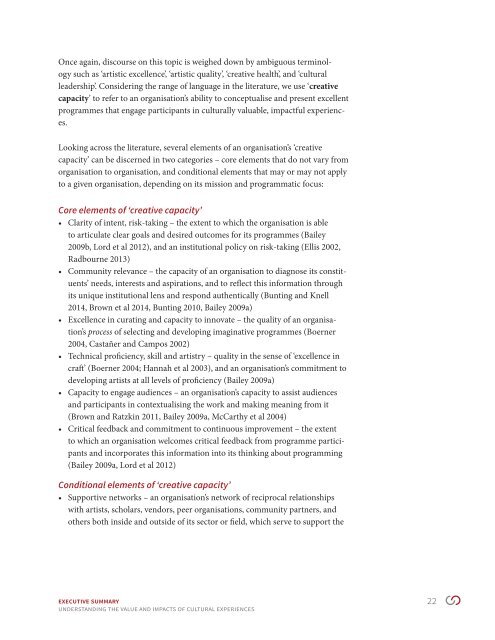aceUVi
aceUVi
aceUVi
You also want an ePaper? Increase the reach of your titles
YUMPU automatically turns print PDFs into web optimized ePapers that Google loves.
Once again, discourse on this topic is weighed down by ambiguous terminology<br />
such as ‘artistic excellence’, ‘artistic quality’, ‘creative health’, and ‘cultural<br />
leadership’. Considering the range of language in the literature, we use ‘creative<br />
capacity’ to refer to an organisation’s ability to conceptualise and present excellent<br />
programmes that engage participants in culturally valuable, impactful experiences.<br />
Looking across the literature, several elements of an organisation’s ‘creative<br />
capacity’ can be discerned in two categories – core elements that do not vary from<br />
organisation to organisation, and conditional elements that may or may not apply<br />
to a given organisation, depending on its mission and programmatic focus:<br />
Core elements of ‘creative capacity’<br />
• Clarity of intent, risk-taking – the extent to which the organisation is able<br />
to articulate clear goals and desired outcomes for its programmes (Bailey<br />
2009b, Lord et al 2012), and an institutional policy on risk-taking (Ellis 2002,<br />
Radbourne 2013)<br />
• Community relevance – the capacity of an organisation to diagnose its constituents’<br />
needs, interests and aspirations, and to reflect this information through<br />
its unique institutional lens and respond authentically (Bunting and Knell<br />
2014, Brown et al 2014, Bunting 2010, Bailey 2009a)<br />
• Excellence in curating and capacity to innovate – the quality of an organisation’s<br />
process of selecting and developing imaginative programmes (Boerner<br />
2004, Castañer and Campos 2002)<br />
• Technical proficiency, skill and artistry – quality in the sense of ‘excellence in<br />
craft’ (Boerner 2004; Hannah et al 2003), and an organisation’s commitment to<br />
developing artists at all levels of proficiency (Bailey 2009a)<br />
• Capacity to engage audiences – an organisation’s capacity to assist audiences<br />
and participants in contextualising the work and making meaning from it<br />
(Brown and Ratzkin 2011, Bailey 2009a, McCarthy et al 2004)<br />
• Critical feedback and commitment to continuous improvement – the extent<br />
to which an organisation welcomes critical feedback from programme participants<br />
and incorporates this information into its thinking about programming<br />
(Bailey 2009a, Lord et al 2012)<br />
Conditional elements of ‘creative capacity’<br />
• Supportive networks – an organisation’s network of reciprocal relationships<br />
with artists, scholars, vendors, peer organisations, community partners, and<br />
others both inside and outside of its sector or field, which serve to support the<br />
Executive Summary 22<br />
UNDERSTANDING the value and impacts of cultural experiences


